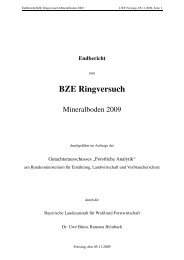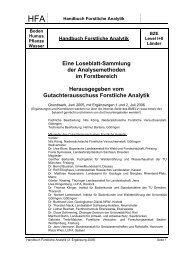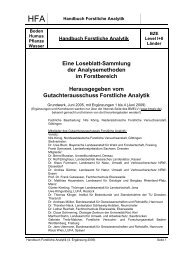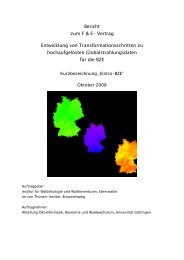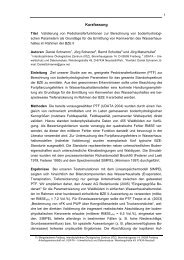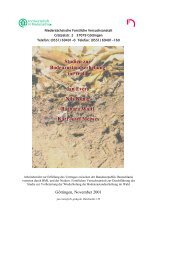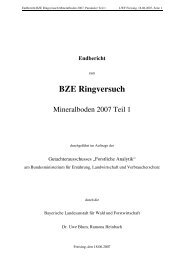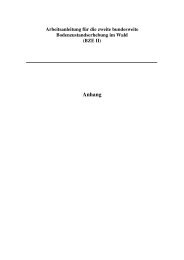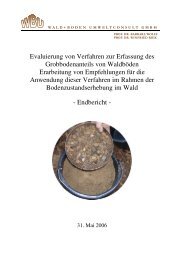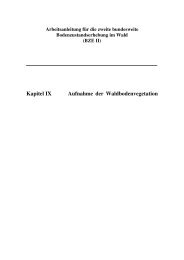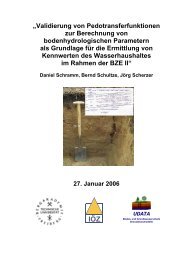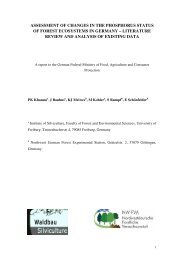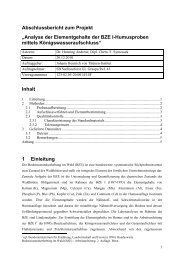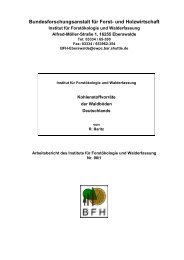assessment of changes in the phosphorus status of forest ...
assessment of changes in the phosphorus status of forest ...
assessment of changes in the phosphorus status of forest ...
Create successful ePaper yourself
Turn your PDF publications into a flip-book with our unique Google optimized e-Paper software.
Douglas fir which suffered from absolute and relative P deficiencies. Accord<strong>in</strong>g to<br />
Van den Burg (1990) <strong>the</strong> <strong>in</strong>creas<strong>in</strong>g N deposition <strong>in</strong> <strong>the</strong> south-eastern part <strong>of</strong> <strong>the</strong><br />
Ne<strong>the</strong>rlands is largely responsible for <strong>the</strong> present absolute and relative <strong>phosphorus</strong><br />
deficiencies <strong>in</strong> current needles <strong>of</strong> Douglas firs, whereas <strong>in</strong> p<strong>in</strong>e needles <strong>the</strong><br />
calcium and absolute and relative magnesium contents were mostly affected. This<br />
contrast<strong>in</strong>g behaviour among Douglas fir and p<strong>in</strong>es was related to <strong>the</strong> preference<br />
<strong>of</strong> nitrate uptake by Douglas fir suppress<strong>in</strong>g <strong>the</strong> uptake <strong>of</strong> P.<br />
• U.K.<br />
Harrison et al. (1999) studied <strong>the</strong> effects <strong>of</strong> pollutants on beech, Scots p<strong>in</strong>e and<br />
Sitka spruce stands grow<strong>in</strong>g on a range <strong>of</strong> comparable soils <strong>in</strong> <strong>the</strong> UK. They<br />
<strong>in</strong>vestigated <strong>the</strong> canopy conditions <strong>of</strong> <strong>the</strong> stands <strong>in</strong> relation to <strong>the</strong> possible role <strong>of</strong><br />
P limitation. Use <strong>of</strong> a root bioassay and a res<strong>in</strong>-extraction procedure to assess <strong>the</strong><br />
availability <strong>of</strong> P <strong>in</strong> surface soil <strong>in</strong>dicated that a higher level <strong>of</strong> P stress <strong>in</strong> stands<br />
with <strong>the</strong> th<strong>in</strong>ner canopy was observed <strong>in</strong> eight out <strong>of</strong> <strong>the</strong> n<strong>in</strong>e paired stands <strong>of</strong><br />
Sitka spruce, Scots p<strong>in</strong>e and beech suggest<strong>in</strong>g <strong>the</strong> need to monitor <strong>the</strong> acid <strong>in</strong>puts<br />
on affected plots;<br />
• Canada<br />
For an area <strong>in</strong> central Ontario with high atmospheric N depositions, Grawdoski<br />
and Thomas (2006) reported that <strong>the</strong> annual stem growth <strong>of</strong> sugar maple (last 5<br />
year average) was limited by available P levels measured by us<strong>in</strong>g <strong>the</strong> Bray 1<br />
method. Variations <strong>in</strong> this measure <strong>of</strong> P availability <strong>in</strong> <strong>the</strong> surface soils expla<strong>in</strong>ed<br />
74% <strong>of</strong> variance <strong>in</strong> growth. Low P values were associated with low soil pH <strong>in</strong> <strong>the</strong><br />
root zone.<br />
• Germany<br />
Polle et al. (1992) found that foliar P <strong>in</strong> 3 Norway spruce stands grow<strong>in</strong>g at<br />
different altitudes <strong>in</strong> calcareous Alps <strong>of</strong> Bavaria were <strong>in</strong> <strong>the</strong> deficient range.<br />
Thomas and Büttner (1998) reported limit<strong>in</strong>g values <strong>of</strong> P <strong>in</strong> <strong>the</strong> leaves <strong>of</strong> Quercus<br />
petraea. He<strong>in</strong>sdorf and Branse (2002) followed element concentrations <strong>in</strong> p<strong>in</strong>e<br />
stands grow<strong>in</strong>g <strong>in</strong> Brandenburg, Germany, between 1964 and 1999 and found no<br />
clear decrease <strong>of</strong> P <strong>in</strong> needles. Similarly Mellet et al. (2004) <strong>in</strong> <strong>the</strong>ir review <strong>of</strong><br />
foliar concentrations <strong>in</strong> <strong>the</strong> context <strong>of</strong> <strong>the</strong> RECOGNITION project found no clear<br />
evidence <strong>of</strong> P decrease <strong>in</strong> <strong>the</strong> foliage <strong>of</strong> conifer stands, especially that <strong>of</strong> p<strong>in</strong>e.<br />
(b) Field and laboratory studies under controlled conditions.<br />
There are a number <strong>of</strong> case studies <strong>in</strong> <strong>the</strong> literature, where acidify<strong>in</strong>g substances were<br />
applied to <strong>forest</strong>s ei<strong>the</strong>r under field conditions or under controlled laboratory<br />
conditions <strong>in</strong> order to determ<strong>in</strong>e <strong>the</strong> <strong>changes</strong> <strong>in</strong> <strong>the</strong> nutrition <strong>of</strong> trees and/or soil P<br />
13



